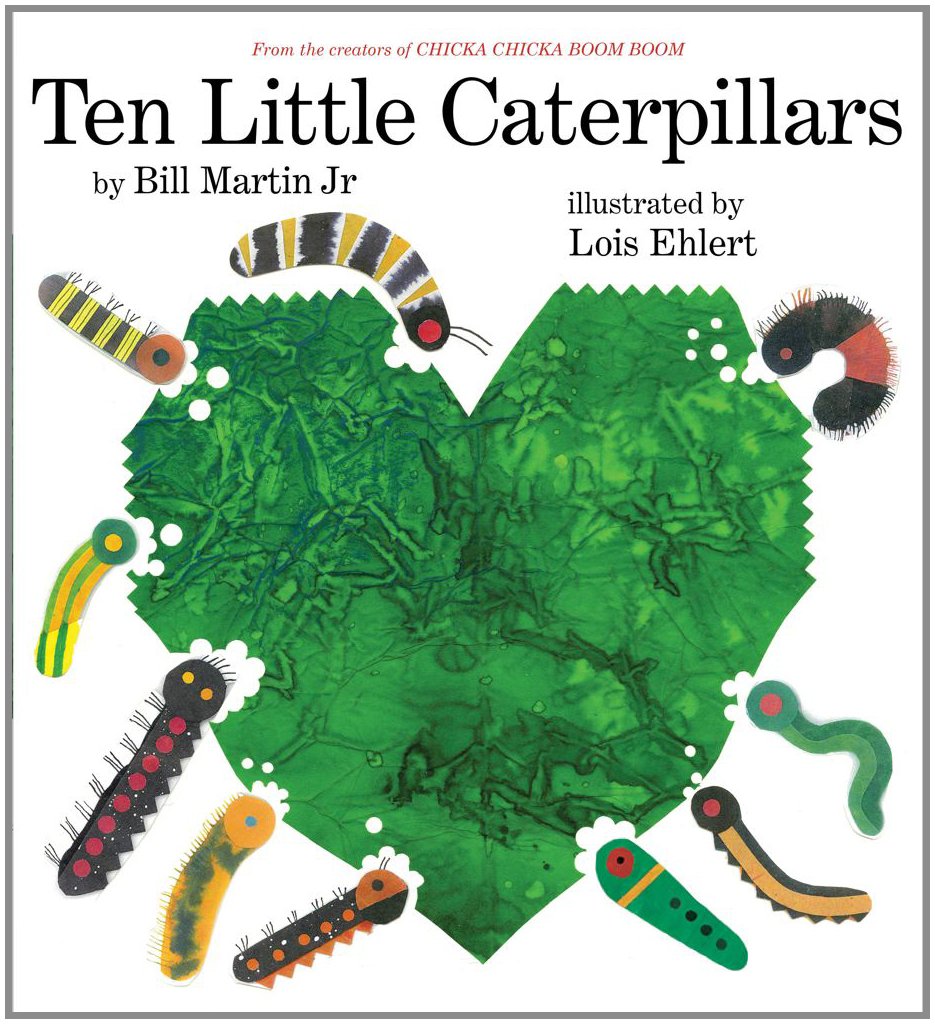Picturebook Review of Ten Little Caterpillars by Bill Martin Jr.
Text
1. The text of a children's book is usually organized into simple sentences and short paragraphs. How is the text organized in the book that you have chosen to review? Explain whether this organization was sufficient for the story that this book is telling. The text in Ten Little Caterpillars is organized with short simple sentences. One sentence that spreads around two pages. Yes, the organization of the sentences is sufficient to the telling of the story, because it is a math-based picture book. Each page is based on one number.
2. Children's book authors often employ literary tools to help make the story more vivid in the readers minds. Commonly used literary tools are rhythm, alliteration, repetition, refrains, onomatopoeia, simile, personification, rhyme, and imagery. Identify three different areas in the text where a literary tool has been employed. For each example you identify, state the type of literary tool that is used and how the employment of the tool helps support the story. The three different literacy tools that were employed in this story were refrains, repetition, rhyme and rhythm.
- Rhymes were used throughout the book. The last word of the sentence rhymes with the last word of the next sentence.
- Repetitions were used in the story by repeating the rhymes throughout the story.
- Rhythm and repetition can go hand in hand in this story depending on how you read the story. This is a story I read as if is a poem. My child loves it!
3. Identify two areas in the text that use a question or other device to help move the reader to the next page.
This book is a math-based picture book, each page is a different number. The numbers move you on to the next page. Also, the numbers count down from 10-1.
Images
1. Some picture books have an images on the front cover that presents the main conflict or point of the story. Identify two or more elements from the front cover of the book you are reviewing and explain how they relate to the story.
The cover of the Ten Little Caterpillars by Bill Martin Jr. shows the main characters of the story.
2. What is the primary medium (collage, drawings, photographs, etc.) used in the images?
This book is illustrated by Lois Ehlert. The book states that the illustrations in the book are a watercolor collage.
3. Identify the image that in your opinion is the most effective in developing the story as a whole. Explain how two or more elements in the illustration help support and develop the story. If you can, insert a screenshot of the image into your blog.
This is image in my opinion is the most effective in developing the whole story, because caterpillars become butterflies. Throughout the story the caterpillars are portrayed through nature. Also, the illustrations in the story make the caterpillars look life- like.
4. Identify two elements that are repeated throughout a majority of the images. Explain how these elements support the story. If you can insert a screenshot into your blog.

The images that are repeated in the story is the portrayed of the caterpillars in their nature habitat. They are found on flowers and leaves.
5. Find an example of how the images and text work together to create irony,metaphor and/or metonymy. If you can insert a screenshot of the image into your blog.
A group of caterpillars is called an army. On this page the caterpillar is frightened by a hen. In my opinion, I think this is ironic because an army is not suppose to be frightened. I do realize only one caterpillar is one this page by the title of the book is Ten Little Caterpillars.
Characterization
1. What is the easily identifiable dominant trait of the story's main character?
The main characters are caterpillars. The identifiable dominant trait is that that caterpillars are small, fuzzy and crawl.
2. Identify a character trait of the main character that is established through the text.
A character trait of the main character that is established through the text, is the idea that caterpillars move. Each page states a different action of the caterpillars.
3. Identify a character trait of the main character that is established through the images.
A character trait of the main character that is established through the images, is the idea that caterpillars like to eat leaves.
4. Identify two character traits of the main character that young children identify or sympathize
with.
Young children will identify with the caterpillar going to school and the caterpillar crawling in the flowers. Children don't crawl in the flowers but usually like to pick them.
5. What was the main problem that the main character faces in the book? How is this problem similar to a problem that most children have faced before?
I need it as a problem but the caterpillar turns into a butterfly. Children can identify with things changing. They are use to their own body changing such as loosing their teeth and growing new ones.
6. Sometimes a children's book character will solve the main conflict on his or her own. How did the character in the book you selected turn to self-reliance to solve the main conflict of the story?
The caterpillar ate leaves, made a chrysalis and turned into a butterfly.
Reference:
Jr. Martin, B. (2011). Ten little caterpillars. New York, NY: Simon & Schuster Children's Publishing Division.






No comments:
Post a Comment